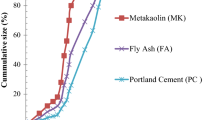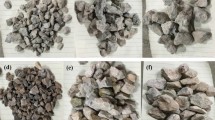Abstract
The objective of this research was to incorporate recycled aggregate into pervious concrete to create a very sustainable concrete product for many applications. The research methodology interested replacing natural aggregate with recycled aggregate in the pervious concrete production at 4 different replacement levels of 25, 50, 75 and 100 %, with two different water-to-cement ratios of 0.27 and 0.32. Single sized recycled and natural aggregate, passing from 12.5-mm sieve and retained on 9.5-mm sieve, were used in the manufacturing of pervious concrete. Totally ten different concrete mixtures were produced and each of the concrete batches was tested for dry density, porosity, compressive and splitting tensile strength, water permeability and abrasion resistance. The properties of pervious concrete produced with recycled aggregate were also evaluated by statistical technique, namely GLM-ANOVA. The experimental results showed that the properties of pervious concrete were significantly affected by using recycled aggregate. Substituting the natural aggregate with recycled aggregate resulted in a considerable increment in permeability coefficient. However, it was observed that the mechanical properties of such concretes were adversely influenced up to a certain degree.









Similar content being viewed by others
References
Portland Cement Association (PCA) (2009) Materials: recycled aggregates, http://www.cement.org/tech/cct_aggregates_recycled.asp. Accessed 2 July 2009
ACI 522R-10 (2010) Pervious concrete, American Concrete Institute Committee, Farmington Hills
Tennis PD, Leming ML, Akers DJ (2004) Pervious concrete pavements. EB 302, Portland Cement Association, Skokie, Illinois, and National Ready Mixed Concrete Association, Silver Spring
Bury MA, Mawby CA, Fisher D (2006) Making pervious concrete placement easy: using a novel admixture system. Concrete in focus, pp 55–59
Meininger RC (1998) No-Fines pervious concrete for paving. Concr Int 10(8):20–27
Neithalath N (2004) Development and characterization of acoustically efficient cementitious materials, PhD thesis, Purdue University, West Lafayette
NRMCA (2006) Ready mixed concrete industry LEED reference guide, Silver Springs. http://www.rmc-foundation.org
Collins KA, Hunt WF, Hathaway JM (2008) Hydrologic comparison of four types of permeable pavement and standard asphalt in Eastern North Carolina. J Hydrol Eng 13(12):1146–1157
Yang J, Jiang G (2003) Experimental study on properties of pervious concrete pavement materials. Cem Concr Res 33:381–386
Crouch L, Cates M, Dotson V, Honeycutt K, Badoe D (2003) Measuring the effective air void content of portland cement pervious pavements, Cement, concrete, and aggregates, vol 25, No. 1, West Conshohocken
Crouch LK, Pitt J, Hewitt R (2007) Aggregate effects on pervious Portland cement concrete static modulus of elasticity. J Mater Civ Eng 19(7):561–568
Ghafoori N, Dutta S (1995) Laboratory investigation of compacted no-fines concrete for paving materials. J Mater Civ Eng 7(3):183–191
Zhuge Y (2006) A review of permeable concrete and its application to pavements. Mech Struct Mater 30:601–607
Shackel B, Pearson A (2003) Permeable concrete eco-paving as best management practice in Australian urban road engineering. In: Proceeding of the 21st ARRB and 11th REAAA Conference, 2003, Cairns
Kevern JT, Schaefer VR, Wang K, Suleiman MT (2008) Pervious concrete mixture proportions for improved freeze-thaw durability. J ASTM Int 5(2):12
Neithalath N (2007) Extracting the performance predictors of enhanced porosity concretes from electrical conductivity spectra. Cem Concr Res 37:796–804
Neithalath N, Weiss J, Olek J (2006) Characterizing enhanced porosity concrete using electrical impedance to predict acoustic and hydraulic performance. Cem Concr Res 36(11):2074–2085
Wang K, Schaefer VR, Kevern JT, Suleiman MT (2006) Development of mix proportion for functional and durable pervious concrete. NRMCA concrete technology forum: focus on pervious concrete, Nashville
Haselbach T, Freeman LM, Robert M (2006) Vertical porosity distributions in pervious concrete pavement. ACI Mater J 109:149
Marolf A, Neithalath N, Sell E, Wegner K, Weiss J, Olek J (2004) Influence of aggregate size and gradation on acoustic absorption of enhanced porosity concrete. ACI Mater J 101(1):82–91
Murao K, Yuasu Y, Misima N, Hatanaka S (2002) Experimental study on the strength of porous concrete with low quality recycled aggregate. J Archit Inst Jpn 8:823–824
Tu TY, Chen YY, Hwang CL (2006) Properties of HPC with recycled aggregates. Cem Concr Res 36:943–950
Zega CJ, Villagran-Zaccardi YA, Di Maio AA (2010) Effect of natural coarse aggregate type on the physical and mechanical properties of recycled coarse aggregate. Mater Struct 43:195–202
Rizvi R, Tighe SL, Norris J, Henderson V (2010) Incorporating recycled concrete aggregate in pervious concrete pavements. In: Proceeding from the National Transportation Research Board, Washington, D.C
Zhuge Y (2008) Comparison the performance of recycled and quarry aggregate and their effect on the strength of permeable concrete. 20th Australasian conference on the mechanics of structures and materials, Toowoomba, December 2008, pp 343–349
Poon CS (2004) Influence of moisture states of natural and recycled aggregates on the slump and compressive strength of concrete. Cem Concr Res 34:31–36
Domingo A, Lazaro C, Gavarre FL, Serrano MA, Lopez-Colina C (2010) Long term deformation by creep and shrinkage in recycled aggregate concrete. Mater Struct 43:1147–1160
ASTM C1754/C1754M.12 (2012) Standard test method for density and void content of hardened pervious concrete. ASTM International, West Conshohocken
ASTM C39/C39M-12 (2012) Standard test method for compressive strength of cylindrical concrete specimens, vol 04-02. Annual Book of ASTM Standard, Philadelphia
ASTM C496 (2011) Standard test method for splitting tensile strength of cylindrical concrete specimens, vol 04-02. Annual Book of ASTM Standard, Philadelphia
ASTM C29 (2010) Standard test method for bulk density (“Unit Weight”) and voids in aggregate. Annual Book of ASTM Standard, Philadelphia
DIN52108 (2002) Wear testing of inorganic, nonmetallic materials using the Böhme abrasive wheel
Minitab R12, Statistical tool, quality plaza, State College
Author information
Authors and Affiliations
Corresponding author
Rights and permissions
About this article
Cite this article
Güneyisi, E., Gesoğlu, M., Kareem, Q. et al. Effect of different substitution of natural aggregate by recycled aggregate on performance characteristics of pervious concrete. Mater Struct 49, 521–536 (2016). https://doi.org/10.1617/s11527-014-0517-y
Received:
Accepted:
Published:
Issue Date:
DOI: https://doi.org/10.1617/s11527-014-0517-y




